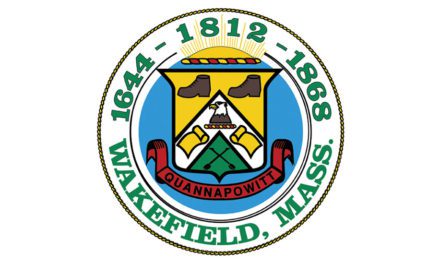Published July 8, 2021
By MAUREEN DOHERTY
NORTH READING — Now in the fifth year of a five-year grant cycle, the town’s Drug-Free Communities Grant Director Amy Luckiewicz has completed the 2021 Core Measurement Report of youth substance use surveys of the town’s students in grades 6-12.
With the strange scheduling this year, the 2021 survey captured a high percentage of all grades with the exception of high school juniors, as just two students had completed their survey, therefore she said those results cannot be considered statistically relevant although she thanked those two students for turning in their surveys.
Participation rates in the survey among the other six grades ranged from 54% of seventh graders to a high of 92% of ninth graders, with a margin of error between 2% to 7%.
Since 2020 was also a wash due to COVID shutdowns, Luckiewicz compiled comparison charts for each section of the survey against the surveys from 2018 and 2019.
The good news is in virtually all categories, youth substance use in town has declined overall from 2018 to 2021. But there remains much room for improvement.
The survey asks the students to rate their use of different substances in the past 30 days.
For instance, student use of alcohol in the past 30 days typically saw declines.
A total of 2.7% of sixth-graders reported having used alcohol in the previous 30 days this year whereas in 2019 that rate was 2.9% and in 2018 it was 6.3%.
Seventh graders held steady over the three years: 2.94% this year; 2.9% in 2019 and 2.5% in 2018.
Usage of alcohol increased among eighth-graders this year, with 5.26% reported having used it in the past 30 days whereas just 1.8% had done so in 2019 but 7.2% had used in 2018.
The high school years see a definite uptick in usage of alcohol.
A total of 7.69% of this year’s freshmen reported having drunk alcohol in the past 30 days with 9% having done so in 2019 and 10.2% in 2018.
In the sophomore class, there was a precipitous drop this year (11.56%) vs. 2019 (20.6%) and 2018 (20.9%).
Seniors had the highest alcohol usage, but had still cut the rate nearly in half this year over the previous two years. A total of 26.32% reported having a drink in the past 30 days this year compared to 43.4% in 2019 and 43.0% in 2018.
In reporting these findings to the Select Board recently, Luckiewicz said there is “definitely a casual attitude of alcohol use; they see adults using it and it is not a big deal,” she said.
This coming school year Luckiewicz said that she and School Resource Officer Det. Paul Lucci are planning to develop a new program for parents with regard to curbing alcohol use among their teens. Noting that teen’s most consistently self-report that they access alcohol or other substances “at a friend’s home” is indicative of a pattern, she believes, in which there are homes where use is allowed which she attributed to a prevailing adult attitude that they’d prefer their kids and their friends drink or smoke under their own roof than somewhere else. On the other end of the spectrum are the parents who know where the teen parties are taking place but they tell her that they don’t want to report what’s happening due to the social pressure within their own circle of friends.
Luckiewicz said if the parents are feeling this kind of pressure, imagine the pressure the teens are facing. However, if the parents agree to a consistent set of rules when their kids violate a compact around substance use she believes they could better succeed in stemming use of alcohol, tobacco, marijuana and vape products even further.
Tobacco, pot and vaping
The addition of vaping to the mix of delivery options for tobacco and marijuana, both of which are legal for those over 21 in Massachusetts, has added a new layer of complexity when it comes to these highly addictive substances.
The irony is that vaping was originally touted as a means for tobacco smokers to ease themselves off cigarettes as well as a means to eliminate the second-hand smoke and odor from cigarettes, thereby making it less irritating to those around them. But when it comes to teens who vape, the reality is they can get addicted to the nicotine quite quickly when it is delivered in this way. This means when vaping is not available they will turn to the accessible option to get that nicotine fix, a traditional cigarette.
Take the current senior class. While just 5.13% admit to smoking a cigarette in the past 30 days, compared to 9.7% in 2019 and 8.7% in 2018, the percentage of seniors who admitted to smoking or using marijuana in the same timeframe was 20.69% in 2021; 31.9% in 2019 and 23.5% in 2018.
Vaping numbers were surveyed first in 2019 when 25.4% of seniors admitted to vaping while two years later that number has dropped to 15.52%. What effect the state’s various bans on flavored vaping products has had in that reduction remain unclear, however. Luckiewicz stated that these products are still available in New Hampshire and anecdotally she is aware of older siblings, friends or other relatives who have supplied teens with the products when they take a run up north.
When it comes to vaping, the most significant drop in usage was among sophomores between 2019 and 2021. A total of 21.2% of sophomores reported vaping in 2019 compared to 7.53% in 2021. Similarly, the numbers for freshmen also went down, from 9.0% to 5.83%. A jump in usage was noted among sixth graders — from 0.7% in 2019 to 2.72% this year.
Marijuana use has also seen a decline among the current sophomore class at 9.59% this year versus 16.5% in 2019 and 16.2% in 2018.
Eighth-graders saw a more than 3% increase in usage from 2019 to 2021 (3.0% vs 6.14%). No seventh graders reported using pot this year whereas 2.2% had done so in 2019, but 2.7% of this year’s sixth-graders reported using pot compared to 1.5% in 2019 and 5.5% in 2018.
Use of prescription drugs among students has the lowest use among all substances students admit to using. Luckiewicz stated that these would be classified as prescription drugs that were not prescribed for that child by a health care provider.
In 2021, 2.04% of sixth-graders, 0% of seventh-graders, 5.22% of eighth-graders, 3.33% of freshmen, 2.72% of sophomores and 2.59% of seniors reported they had done so. These numbers are down compared to 2018 among students in grades six (6.3%), 10 (4.6%) and 12 (8.7%). They are up for grade seven (1.2%) while grade 9 remained unchanged (3.3%).
The overall summary for all grades (except grade 11) showed that student use of alcohol declined from just over 16% in 2018 to just over 13% in 2019 to just under 9% in 2021;
• tobacco use dropped from about 5% in 2018 to under 4% in 2019 but increased to 4% in 2021;
• marijuana use has dropped from nearly 16% in 2018 to 10% in 2019 to 7.75% in 2021;
• prescription drug use hovered around 4% in 2018 and 2019 but has dropped to about 2.5% in 2021;
• vaping dropped overall from about 10.5% in 2019 to about 6.25% in 2021.
Where do they use substances?
The most popular places for students of all ages to use substances of all types mentioned in the 2021 survey is “at a friend’s house” for alcohol, tobacco, pot or vaping; at home for prescription drugs.
The second most popular place for alcohol, tobacco, pot or vaping was “at home” while prescription drug use was “in a car.”
In 2020, “on school grounds” was selected as the most popular place to consume tobacco, pot, prescription drugs or vape while alcohol was used as a friend’s house.
Where does North Reading compare with national trends in substance use in the prior 30 days?
The data was tracked among eighth, 10th and 12th graders only.
• Alcohol: 8th (nationally: 9.9%; NR: 5.26%); 10th (nationally: 20.3%; NR: 11.56%); 12th (nationally: 33.6%; NR: 26.32%)
• Tobacco: 8th (nationally: 2,2%; NR: 5.26%); 10th (nationally: 3.2%; NR: 4.76%); 12th (nationally: 7.5%; NR: 5.13%)
• Marijuana: 8th (nationally: 6.5%; NR: 6.14%); 10th (nationally: 16.6%; NR: 9.59%); 12th (nationally: 21.1%; NR: 20.69%) • Rx Drugs: 8th (nationally: not available; NR: 5.26%); 10th (nationally: not available; NR: 3.40%); 12th (nationally: 3.3%; NR: 2.59%).




